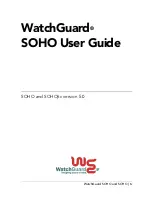
•
By stripping the URG bit by default from all TCP segments traversing the system (configurable
via Advanced Settings > TCP > TCPUrg).
WinNuke attacks will usually show up in NetDefendOS logs as normal drops with the name of the
IP rule that disallowed the connection attempt.
For connections allowed through the system, "TCP" or "DROP" category (depending on the
TCPUrg setting) entries will appear, with a rule name of "TCPUrg". The sender IP address is not
likely to be spoofed; a full three-way handshake must be completed before out-of-band segments
can be sent.
6.6.7. Amplification attacks: Smurf, Papasmurf, Fraggle
This category of attacks all make use of "amplifiers": poorly configured networks who amplify a
stream of packets and send it to the ultimate target. The goal is excessive bandwidth consumption -
consuming all of the victim's Internet connection capacity. An attacker with sufficient bandwidth
can forgo the entire amplification stage and simply stream enough bandwidth at the victim.
However, these attacks allows attackers with less bandwidth than the victim to amplify their data
stream to overwhelm the victim.
•
"Smurf" and "Papasmurf" send ICMP echo packets to the broadcast address of open networks
with many machines, faking the source IP address to be that of the victim. All machines on the
open network then "respond" to the victim.
•
"Fraggle" uses the same general idea, but instead using UDP echo (port 7) to accomplish the
task. Fraggle generally gets lower amplification factors since there are fewer hosts on the
Internet that have the UDP echo service enabled.
Smurf attacks will show up in NetDefendOS logs as masses of dropped ICMP Echo Reply packets.
The source IP addresses will be those of the amplifier networks used. Fraggle attacks will show up
in NetDefendOS logs as masses of dropped (or allowed, depending on policy) packets. The source
IP addresses will be those of the amplifier networks used.
Avoiding Becoming an Amplifier
Even though the brunt of the bandwidth stream is at the ultimate victim's side, being selected as an
amplifier network can also consume great resources. In its default configuration, NetDefendOS
explicitly drops packets sent to broadcast address of directly connected networks (configurable via
Advanced Settings > IP > DirectedBroadcasts). However, with a reasonable inbound policy, no
protected network should ever have to worry about becoming a smurf amplifier.
Protection on the Victim's Side
Smurf, and its followers, are resource exhaustion attacks in that they use up Internet connection
capacity. In the general case, the firewall is situated at the "wrong" side of the Internet connection
bottleneck to provide much protection against this class of attacks. The damage has already been
done by the time the packets reach the firewall.
However, NetDefendOS can help in keeping the load off of internal servers, making them available
for internal service, or perhaps service via a secondary Internet connection not targeted by the
attack.
•
Smurf and Papasmurf type floods will be seen as ICMP Echo Responses at the victim side.
Unless FwdFast rules are in use, such packets are never allowed to initiate new connections,
regardless of whether or not there are rules that allow the traffic.
•
Fraggle packets may arrive at any UDP destination port targeted by the attacker. Tightening the
inbound rule set may help.
6.6.7. Amplification attacks: Smurf,
Papasmurf, Fraggle
Chapter 6. Security Mechanisms
334
Summary of Contents for NetDefend DFL-260E
Page 27: ...1 3 NetDefendOS State Engine Packet Flow Chapter 1 NetDefendOS Overview 27...
Page 79: ...2 7 3 Restore to Factory Defaults Chapter 2 Management and Maintenance 79...
Page 146: ...3 9 DNS Chapter 3 Fundamentals 146...
Page 227: ...4 7 5 Advanced Settings for Transparent Mode Chapter 4 Routing 227...
Page 241: ...5 4 IP Pools Chapter 5 DHCP Services 241...
Page 339: ...6 7 Blacklisting Hosts and Networks Chapter 6 Security Mechanisms 339...
Page 360: ...7 4 7 SAT and FwdFast Rules Chapter 7 Address Translation 360...
Page 382: ...8 3 Customizing HTML Pages Chapter 8 User Authentication 382...
Page 386: ...The TLS ALG 9 1 5 The TLS Alternative for VPN Chapter 9 VPN 386...
Page 439: ...Figure 9 3 PPTP Client Usage 9 5 4 PPTP L2TP Clients Chapter 9 VPN 439...
Page 450: ...9 7 6 Specific Symptoms Chapter 9 VPN 450...
Page 488: ...10 4 6 Setting Up SLB_SAT Rules Chapter 10 Traffic Management 488...
Page 503: ...11 6 HA Advanced Settings Chapter 11 High Availability 503...
Page 510: ...12 3 5 Limitations Chapter 12 ZoneDefense 510...
Page 533: ...13 9 Miscellaneous Settings Chapter 13 Advanced Settings 533...
















































